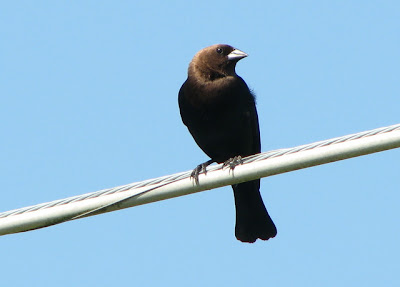Originally from 26 April 2008
I mentioned Brown-headed Cowbirds in a recent post as their frequency of sightings reaches its spring peak in our neighborhood, but I left it at merely commenting on their looks. I'll venture that there are others, maybe even a silent majority, that find the rich brown and lustrous black subtly stunning, but most don't discuss cowbirds unless they are racing to the reasons to hate them.
Cowbirds may be the most vilified bird in North America. Every breeding season you'll find anti-cowbird rants as they make their annual rounds on the Internet, a digital harbinger of spring on par with the noticable increase in posts to birding listserves.

Why hate cowbirds? Easy. They're brood parasites, meaning they're pretty lax in the parental care department. They don't bother with the whole nest building, incubation, or nestling feeding scene. They don't provide care for them once they fledge. Those activities are pretty costly energy expenditures, so they lay their eggs in active nests built by another species and let the "host" parents do the child rearing. If your goal is to simply spread your genes, what better way than to lay all that care and investment on surrogates who'll do it for you? Very productive for the cowbird, but with a potential serious downside for many host species, which usually fledge fewer young, if any at all.
The female cowbird may even eject a host egg from the nest when she deposits hers, and the cowbird nestling(s) will typically hatch sooner and grow faster, outcompeting its nestmates for food. Even if the host's nestlings don't starve in the nest, they typically fledge in such poor condition the odds of survival are significantly stacked against them.

It's a pretty blunt strategy, and clearly, it works. Estimates of their population range from 20 to 40 million birds across North America, where they survive, and thrive, from central Mexico to southern Canada. Couple that with the knowledge that cowbird parasitism is listed as a influential factors in the decline of the endangered Kirtland's Warbler in Michigan and Black-capped Vireo in Oklahoma and Texas and you've got to ask, "so, what's not to hate?"
Well, in my estimation, their breeding strategy is not exactly the problem. Species that evolved with cowbirds through the millenia have learned how to deal with cowbird parasitism. They usually recognize a cowbird egg in their nest, eject it, or scrap everything they've done and start over, building a new nest right over the old eggs.
It's the species that have only recently encountered cowbirds that are in trouble, the species that have no history with them. These are typically neotropical migrants who inhabit large, unbroken tracts of forest where cowbirds did not historically tread. Now that the forests have been so fragmented the cowbirds are able to penetrate and exploit these naive forest-dwelling birds. Layer the parasitism with additional pressures such as loss of habitat, increased nest predation, pesticide applications, and possibly factors not yet recognized, and you've got a recipe for reproductive unsuccess.
Is it fair to hate the native cowbird for an ingrained behavior, coded in its genes, that's evolved over thousands of generations? That individual under your feeder, or displaying in the bare-limbed tree, or chasing that Yellow Warbler through the foliage, is not consciously scheming, it's merely doing what it does. Cowbirds do what cowbirds do, we've just enabled them to do it more proficiently, and to exploit species that don't know how to react.

And given that, I don't hate the cowbirds, I hate the fact we humans have so drastically upset the system. Now we're in the unenviable position of attempting to manage that system to return some sort of balance, which always seems to muck things up even more. One thing I've learned in our small scale attempts to manage our "neighborhood," meaning our yard: once you monkey with it, you've got to keep at it, and it will be years (if not longer) to evaluate your success.
"Thoreau says 'give me a wildness no civilization can endure.' That's clearly not difficult to find. It is harder to imagine a civilization that wildness can endure, yet this is just what we must try to do. Wildness is not just the 'preservation of the world,' it is the world."
-- Gary Snyder
-













